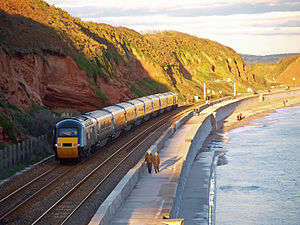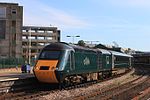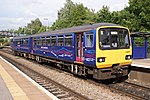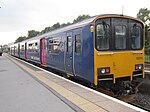Great Western Railway (2015)
| Great Western Railway | |
|---|---|
 
|
|
| Basic information | |
| company | Great Western Railway Ltd. |
| Concession and duration |
InterCity Great Western February 4, 1996 - March 31, 2006 Greater Western April 1, 2006 - March 30, 2019 |
| Parent company | First Group |
| statistics | |
| fleet | 119 British Class 43 for 54 High Speed Train Sets 4 British Class 57 Diesel Locomotives 8 British Class 143 45 British Class 150 12 British Class 153 16 British Class 158 36 British Class 165 21 BR Class 166 5 British Class 180 8 British Class 387 |
| Train stations | over 270 (208 managed) |
| Main regions | South West , South East |
| Secondary regions | Wales , Cotswolds |
| website | |
| www.gwr.com/ | |
Great Western Railway Ltd is a UK rail company of the First Group and operates rail lines from London to the west of England and Wales . The main route is the Great Western Main Line .
The company was formed in 1996 as part of the gradual privatization of British Rail . The concession did not go to an existing private railway company, but was acquired through a management buyout . The company was named Great Western Trains. The name is derived from the Great Western Railway , which was one of the four large private railway companies in Great Britain until nationalization in 1948 and served a similar but slightly larger area.
In 1998, Great Western Trains was acquired by the First Group bus company and was named First Great Western. On April 1, 2006, the concessions of First Great Western, First Great Western Link and Wessex Trains were merged and put out to tender. In addition to the First Group, the National Express Group and the Stagecoach Group also applied . In December 2005, First Group was awarded the contract for a further ten years. On September 20, 2015, the company changed its name to Great Western Railway.
Route network
InterCity
Great Western Railway operates InterCity trains from London Paddington Station to Cardiff and Swansea , Bristol , Exeter , Plymouth and Penzance, and Cheltenham and Gloucester . Other important stations are Reading (where all Great Western Railway InterCity trains stop), Didcot , Swindon , Newport , Westbury and Taunton . Great Western Railway also operates some InterCity trains to Oxford , Worcester and Hereford , and on weekends to Paignton and Newquay .
Suburban and regional traffic
Great Western Railway local trains run from London Paddington Station to Slough , Maidenhead , Reading, Didcot, Oxford, Newbury, Bedwyn , Hereford, Worcester and Banbury . Local trains run from Reading to Basingstoke and via Guildford and Dorking to Gatwick Airport .
Before April 1, 2006, the concession for suburban traffic was separate from the concession for intercity traffic. Originally it was owned by the GoAhead Group under the brand name Thames Trains . The First Group took over the concession at the end of March 2004 and operated the routes until the end of March 2006 under the name First Great Western Link .
The Great Western Railway is also responsible for almost all regional traffic in the South West England region.
stretch
Main lines
- Great Western Main Line (London - Bristol - Exeter - Plymouth - Penzance)
- South Wales Main Line (Bristol - Cardiff - Swansea - West Wales)
- Wessex Main Line (Bristol - Bath - Salisbury - Southampton)
- West Coastway Line (Southampton - Portsmouth - Brighton)
Branch lines
- Atlantic Coast Line (Par – Newquay)
- Avocet Line (Exeter – Exmouth)
- Golden Valley Line (Swindon – Gloucester)
- Heart of Wessex Line (Westbury – Weymouth)
- Looe Valley Line (Liskeard – Looe)
- Maritime Line (Truro – Falmouth)
- Riviera Line (Exeter – Paignton)
- Severn Beach Line (St. Erth – St. Ives)
- Tamar Valley Line (Plymouth – Gunnislake)
- Tarka Line (Exeter – Barnstaple)
business
In the 2004/05 financial year, 22.3 million passengers were carried on the First Great Western network. A total of 2.718 million passenger kilometers were registered, which corresponds to an average journey length of 121 kilometers. 79.6% of all trains were less than 10 minutes late. This value is a low one, even by British standards.
The Great Western Railway has three main workshops: Old Oak Common (three and a half kilometers west of Paddington), Laira near Plymouth and St Phillips Marsh near Bristol Temple Meads Station. Other smaller workshops are located in Penzance, Landore and Exeter.
Rolling stock
- Class 43 - High speed train for long distance express trains; Great Western Railway's HST trains were redesigned at Bombardier in Derby in 2007 and are now equipped with new Grammer seats and sockets
- BR-Class 57 - Locomotives for sleeper and motorail trains
- BR Class 143 - rail buses for suburban service in Bristol
- BR class 150 - diesel multiple units for regional traffic
- BR class 153 - diesel multiple units (mainly for amplifier trains)
- BR class 158 - diesel multiple units for regional traffic
- BR-Class 165 - diesel multiple units for suburban traffic in London
- BR-Class 166 - diesel multiple units on longer suburban lines from London
- BR Class 180 - 'Adelante' diesel multiple units for express trains
- Class 360 - Electric multiple units for the Heathrow Connect offer (joint operation with BAA plc )
| Existing vehicles | |||||
| model series | image | Type | V / max |
passenger cars |
number |
|---|---|---|---|---|---|
| British class 43 |

|
Diesel locomotive | 200 km / h | 119 | |
| British class Mark 3 |

|
Passenger cars | 464 | ||
|
|
|||||
| British class 57 |

|
Diesel locomotive | 152 km / h | 4th | |
| British Class Mark 3 Sleeper |

|
Passenger cars | 200 km / h | 50 | |
| BR class 143 |

|
Railcar (diesel) | 120 km / h | 2 | 8th |
| British class 150/0 |

|
3 | 2 | ||
| British class 150/1 |

|
2 | 15th | ||
| British class 150/2 |

|
2 | 19th | ||
| British class 150/9 |

|
3 | 3 | ||
| British class 153 |

|
1 | 14th | ||
| BR class 158 |

|
145 km / h | 2 | 2 | |
| 3 | 13 | ||||
| British class 165 |

|
2 | 20th | ||
| 3 | 16 | ||||

|
|||||
| BR class 166 |

|
Railcar (diesel) | 145 km / h | 3 | 21st |
| British class 180 |

|
200 km / h | 5 | 5 | |
| British class 387 |

|
Railcar ( electric ) | 177 km / h | 4th | 8th |
| Future fleet | |||||
| model series | image | Type | V / max |
passenger cars |
number |
|---|---|---|---|---|---|
| British class 387 |

|
Railcar ( electric ) | 177 km / h | 4th | 37 |
| British class 800 |

|
Diesel-electric drive | 225 km / h | 5 | 36 |

|
9 | 21st | |||
| British class 802 |

|
5 | 22nd | ||
| 9 | 14th | ||||

